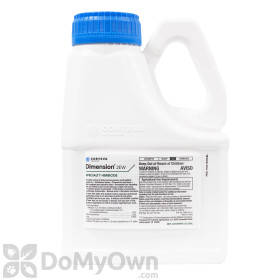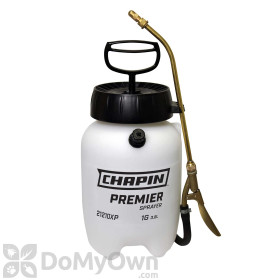
The end of summer means the end of yard care, right? Wrong. Applying a fall pre-emergent treatment is one of the best steps you can take toward a healthy lawn. The gap between the harsh heat of summer and the cool temperatures of fall is a critical time to prepare your lawn for both winter and the following spring.
Keep reading to learn more about pre-emergent herbicides and how to apply them, or select one of the sections below to understand how to better prepare your lawn this fall.
What are Fall Pre-Emergents?
Pre-emergent herbicides help prevent weeds from growing or sprouting when applied on the lawn prior to the target weed seeds germinating. Depending on where you live, fall pre-emergent applications should be done between August and November.
Winter can bring about certain weeds, also known as winter weeds, in your lawn. Chickweed, clover, poa annua (annual bluegrass), and filaree are all weeds that germinate in the winter and emerge in your lawn between late February and early March. You want to apply the pre emergent herbicide before the seed germinates and the weed grows. If you already have winter weeds in your lawn, you would use a post-emergent herbicide.
Pre-emergents come in both a liquid form, which you would apply with a sprayer, and a granular form, which you would apply with a granular spreader. Granules look like sand.
It is hard to kill weeds once they have germinated. By using a fall pre-emergent herbicide treatment, you can prevent weeds from germinating, saving you time and money later in the year and through the spring.
Pre-emergent herbicide applications are especially helpful if you know you have certain weeds that grow in your yard every spring. It helps to find out what type of weeds you have to determine the best fall pre emergent treatment. While you will still need to apply a pre-emergent in the spring, the fall weed control is helpful in case spring comes early and the weather warms before you are able to treat in the spring.

When to Apply Fall Pre-Emergent
The ideal time to apply a fall pre-emergent herbicide to your yard is between August and November. This is true for both cold season and warm-season grasses.
As soil temperatures begin dipping below 70 degrees F, winter annual weeds start to germinate. To stay ahead of these weeds, it's important to apply your fall pre-emergent herbicides before the soil temperatures drop and the weeds germinate, ensuring the pre-emergent herbicide can create a barrier before any weeds can take root.
If you live in a warm climate, apply before temperatures drop. Contact your local extension office for more detailed information on the local climate and when to apply your fall pre-emergent herbicide treatment. Timing for an effective fall pre-emergent application can depend on a variety of factors including the location of where you live, climate, and the type of weeds you are trying to control.
Be sure the air temperature outside is below 85 degrees during application. If it is warmer than 85 degrees, the plants will not absorb as much of the herbicide, which could lead to decreased weed control. If you are wondering how late you can treat weeds in the fall, pre-emergent herbicides are only effective if applied before annual grass weeds germinate. While it's best to apply early, putting down a pre-emergent herbicide before temperatures drop can help control winter weeds and set your lawn up for success next spring.
You will also need to follow-up with a spring pre-emergent application around February or March, before the weather warms in the spring. This ensures another barrier is in place before summer annual weeds begin germinating in the spring as soil temperatures begin to warm.

Which Pre-Emergent Treatment is Best for My Lawn?
There are plenty of pre-emergent herbicide options available, giving you a wide range to choose from. The best fall weed control for your lawn will depend on your turf type, equipment, and the plants you are combating.
First, you must determine what type of turf (grass) you have. Most pre-emergent herbicides are labeled for certain grasses and not others. A pre-emergent herbicide that will work on zoysia grass may destroy St. Augustine grass, and vice-versa. Once you know the type of lawn you have, you can then narrow down your pre-emergent choice. Be certain to read the label of any weed preventer you are considering using to determine if it is compatible with your grass type.
Next, you can narrow your selection further by knowing which weeds you need to target. If you have had certain winter weeds in your lawn in the past, you should choose a selective herbicide that is labeled for pre-emergent control.
Selective herbicides target specific weeds and come in both liquid and granular forms, and in both pre-emergent and post-emergent formulas. Read the label of the selective herbicide to determine if it will cover the weeds commonly found in your lawn if it is labeled as a pre-emergent, and what effect it will have on your lawn.
If you just moved into your home, have not identified which winter weeds your lawn has had previously, or need to target several weeds at once, a selective herbicide for pre-emergent control labeled for a broad spectrum of weeds is a smart choice. There are also non-selective pre-emergent herbicides that will prevent the growth of any vegetation where applied. Always read the label to ensure the product you're using is compatible with your grass.
Finally, you can narrow your selection even further by the mode of application. Liquid pre-emergent herbicides are applied with a sprayer and granular pre-emergents are applied with a spreader. Sprayers are also available in backpack form for easy application, while portable spreaders are helpful for hard-to-reach areas of your lawn. Both applications are equally effective, so the choice depends on which pre-emergent application will be compatible with your turf type, the equipment you may already own, and your comfort level.
How to Apply Pre-Emergents
As mentioned above, pre-emergent herbicides come in two forms: liquid and granular. Learn how to apply pre-emergent herbicides to your lawn in the video below.
How to Apply Liquid Pre-Emergent Herbicides
Liquid pre-emergent herbicides are applied with a sprayer, either a hand pump sprayer or backpack sprayer. To use a liquid pre-emergent:
1. Select the pre-emergent herbicide that is compatible with your grass and the weeds you want to control.
2. Select your choice of sprayer, either a hand pump or backpack sprayer.
3. Read the label of your fall pre-emergent herbicide and add the indicated amount of water and herbicide to your sprayer. Be sure to wear long sleeves, protective goggles, and gloves when mixing and spraying chemicals.
4. Add in a spray indicator dye to your herbicide-water mixture. This dye will temporarily color your grass once it has been sprayed, helping you keep track of what grass has and has not been sprayed during the application process.
5. Shake your water-herbicide-dye mixture thoroughly.
6. Then, you would walk the area of your lawn while spraying your herbicide. Watch the video above for a demonstration of a pre-emergent application.
Products needed for Method 1
How to Apply Granular Herbicides
Granular pre-emergents are applied with a broadcast push spreader or portable hand spreader. To apply granular pre-emergents:
1. Fill your push spreader or hand spreader with the granular pre-emergent herbicide that will work best for your grass type and the weeds you are trying to control.
2. If using a broadcast push spreader, set the spreader to the setting recommended on the label of the granular herbicide. Then, place the spreader on the grass, directly next to your sidewalk or driveway.
3. Place your spreader guard down so that the granules will only broadcast into your lawn and not your sidewalk or driveway. Walk the length of your sidewalk or driveway.
4. Once you have finished walking the length of your sidewalk or driveway, position your spreader a few feet away from the first "row" where you walked. Open the spreader guard so that the granules will now be broadcast from both sides of the spreader.
5. Walk the length of your lawn. Make sure your granules reach the tire marks from your first application row.
6. Continue walking back and forth across your lawn in rows to cover your entire lawn in granules.
7. If using a portable hand spreader, walk the length of your lawn while turning the wheel of your spreader. Walk in rows back and forth, ensuring the granule is distributed evenly across your entire lawn.
Learn how to calibrate a spreader in the video below so you can apply granular pre-emergent herbicides to your lawn yourself.
Products needed for Method 2
Applying fall pre-emergents will save you both time and money. For optimal weed control, both a fall and spring pre-emergent application are necessary. Consult our lawn care schedules for the best time to apply pre-emergents on your lawn.
Ready to apply a pre-emergent? Shop our selection of pre-emergents and selective herbicides or give us a call at 866-581-7378 for assistance.




















